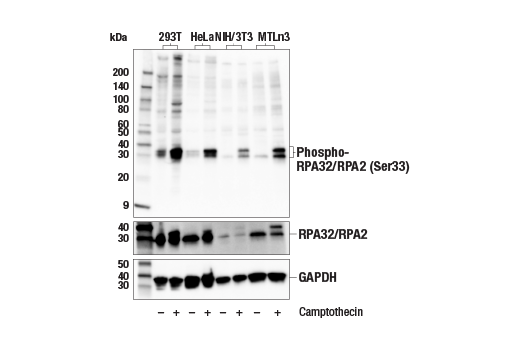 全部商品分类
全部商品分类
产品介绍
产品介绍
产品信息
荧光素标记
抗原名称
RPA32RPA2

来源纯化
Monoclonal antibody is produced by immunizing animals with a synthetic phosphopeptide corresponding to residues surrounding Ser33 of human RPA32/RPA2 protein.

宿主
Rabbit

商品描述
Product Usage Information
| Application | Dilution |
|---|---|
| Western Blotting | 1:1000 |

同种型
Rabbit IgG

分子量
32

应用
反应种属
Human,Mouse,Rat,

目标/特异性
Specificity/Sensitivity
Phospho-RPA32/RPA2 (Ser33) (E9N1T) Rabbit mAb recognizes endogenous levels of RPA32/RPA2 protein only when phosphorylated at Ser33.
Species Reactivity:
Human, Mouse, Rat

敏感性
Endogenous

背景
背景
RPA70 (HSSB, REPA1, RF-A, RP-A, p70) is a component of a heterotrimeric complex, composed of 70, 32/30, and 14 kDa subunits, collectively known as RPA. RPA is a single-stranded DNA binding protein, whose DNA binding activity is believed to reside entirely in the 70 kDa subunit. The complex is required for almost all aspects of cellular DNA metabolism such as DNA replication (1-3), recombination, cell cycle and DNA damage checkpoints, and all major types of DNA repair including nucleotide excision, base excision, mismatch, and double-strand break repairs (4-7). In response to genotoxic stress in eukaryotic cells, RPA has been shown to associate with the Rad9/Rad1/Hus1 (9-1-1) checkpoint complex (8). RPA is hyperphosphorylated upon DNA damage or replication stress by checkpoint kinases including ataxia telangiectasia mutated (ATM), ATM and Rad3-related (ATR), and DNA-dependent protein kinase (DNA-PK) (9-11). Phosphorylation of RPA32 occurs at serines 4, 8, and 33 (11). Hyperphosphorylation may alter RPA-DNA and RPA-protein interactions. In addition to the checkpoint partners, RPA interacts with a wide variety of protein partners, including proteins required for normal replication such as RCF, PCNA, and Pol α, and also proteins involved in SV40 replication, such as DNA polymerase I and SV40 large T antigen (10,12).
1.Liu, V.F. and Weaver, D.T. (1993) Mol. Cell Biol. 13, 7222-31.
2.Wobbe, C.R. et al. (1987) Proc. Natl. Acad. Sci. USA 84, 1834-8.
3.Fairman, M.P. and Stillman, B. (1988) EMBO J. 7, 1211-8.
4.Wold, M.S. and Kelly, T. (1988) Proc. Natl. Acad. Sci. USA 85, 2523-7.
5.Zhou, B.B. and Elledge, S.J. (2000) Nature 408, 433-9.
6.Kastan, M.B. and Bartek, J. (2004) Nature 432, 316-23.
7.Sancar, A. et al. (2004) Annu. Rev. Biochem. 73, 39-85.
8.Guo, S. et al. (2006) J Biol Chem 281, 21607-16.
9.Wu, X. et al. (2005) Oncogene 24, 4728-35.
10.Binz, S.K. et al. DNA Repair (Amst) 3, 1015-24.
11.Nuss, J.E. et al. (2005) Biochemistry 44, 8428-37.
12.Yuzhakov, A. et al. (1999) EMBO J. 18, 6189-99.

翻译后修饰
phosphate

制备和贮存
保存方式
Supplied in 10 mM sodium HEPES (pH 7.5), 150 mM NaCl, 100 µg/mL BSA, 50% glycerol, and less than 0.02% sodium azide. Store at –20°C. Do not aliquot the antibody.
数据库链接
Entrez-Gene ID
6118

UniProt ID
P15927

参考图片
Western blot analysis of extracts from various cell lines, untreated (-) or treated with Camptothecin #13637 (1 μM, 1 hr; +), using Phospho-RPA32/RPA2 (Ser33) (E9N1T) Rabbit mAb (upper), RPA32/RPA2 (4E4) Rat mAb #2208 (middle), or GAPDH (D16H11) XP® Rabbit mAb #5174 (lower). Phospho-RPA32/RPA2 (Ser33) is induced by camptothecin treatment as expected.
声明 :本官网所有报价均为常温或者蓝冰运输价格,如有产品需要干冰运输,需另外加收干冰运输费。







 用小程序,查商品更便捷
用小程序,查商品更便捷




